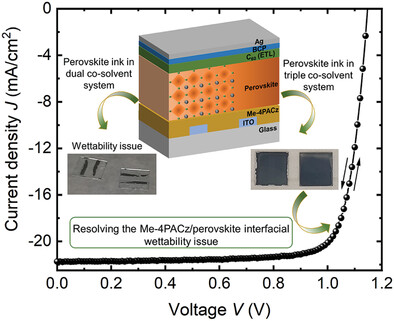Kulkarni, A., Sarkar, R., Akel, S., Häser, M., Klingebiel, B., Wuttig, M., Wiegand, S., Chakraborty, S., Saliba, M., Kirchartz, T.
Adv. Funct. Mater. 2023, 33, 2305812
Perovskite solar cells employing [4-(3,6-dimethyl-9H-carbazol-9-yl)butyl]phosphonic acid (Me-4PACz) self-assembled monolayer as the hole transport layer have been reported to demonstrate a high device efficiency. However, the poor perovskite wetting on Me-4PACz caused by poor perovskite ink interaction with the underlying Me-4PACz presents significant challenges for fabricating efficient perovskite devices. A triple co-solvent system comprising dimethylformamide (DMF), dimethyl sulfoxide (DMSO), and N-methyl-2-pyrrolidone (NMP) is employed to improve the perovskite ink – Me-4PACz coated substrate interaction and obtain a uniform perovskite layer. In comparison to DMF- and DMSO-based inks, the inclusion of NMP shows considerably higher binding energies of the perovskite ink with Me-4PACz as revealed by density-functional theory calculations. With the optimized triple co-solvent ratio, the perovskite devices deliver high power conversion efficiencies of >20%, 19.5%, and ≈18.5% for active areas of 0.16, 0.72, and 1.08 cm2, respectively. Importantly, this perovskite ink–substrate interaction approach is universal and helps in obtaining a uniform layer and high photovoltaic device performance for other perovskite compositions such as MAPbI3, FA1−xMAxPbI3–yBry, and MA-free FA1−xCsxPbI3–yBry.

Kulkarni, A., Sarkar, R., Akel, S., Häser, M., Klingebiel, B., Wuttig, M., Wiegand, S., Chakraborty, S., Saliba, M., Kirchartz, T.
Adv. Funct. Mater. 2023, 33, 2305812
Perovskite solar cells employing [4-(3,6-dimethyl-9H-carbazol-9-yl)butyl]phosphonic acid (Me-4PACz) self-assembled monolayer as the hole transport layer have been reported to demonstrate a high device efficiency. However, the poor perovskite wetting on Me-4PACz caused by poor perovskite ink interaction with the underlying Me-4PACz presents significant challenges for fabricating efficient perovskite devices. A triple co-solvent system comprising dimethylformamide (DMF), dimethyl sulfoxide (DMSO), and N-methyl-2-pyrrolidone (NMP) is employed to improve the perovskite ink – Me-4PACz coated substrate interaction and obtain a uniform perovskite layer. In comparison to DMF- and DMSO-based inks, the inclusion of NMP shows considerably higher binding energies of the perovskite ink with Me-4PACz as revealed by density-functional theory calculations. With the optimized triple co-solvent ratio, the perovskite devices deliver high power conversion efficiencies of >20%, 19.5%, and ≈18.5% for active areas of 0.16, 0.72, and 1.08 cm2, respectively. Importantly, this perovskite ink–substrate interaction approach is universal and helps in obtaining a uniform layer and high photovoltaic device performance for other perovskite compositions such as MAPbI3, FA1−xMAxPbI3–yBry, and MA-free FA1−xCsxPbI3–yBry.